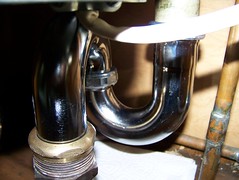By Bill Aldridge
I realize that it is less
than a week until the Christmas holiday.
You are probably busy trying to put the last minute touches on the
holiday decorations, the menu for Christmas dinner, not to mention completing
Santa’s list and getting ready for the arrival of relatives. So this is probably not the time of year that
you normally spend a lot of time thinking about your plumbing. But perhaps it should be. With the holidays can come stress not only to
you, your budget and your household, but also to your home’s plumbing. The influx of guests can have a number of
unexpected consequences to your plumbing that can do more damage to your
holiday budget than a few Chistmas gifts ever could. So in order to keep you from adding a plumber
to your list of holiday guests, I have prepared a list of items that you should
double check while you still have time.
The Ghost of Christmas Dinner Past
While the stresses of
preparing the holiday feast can leave many overwhelmed, think of how your pipes
feel. Particularly if you allow
relatives or family friends to help you with the cleanup after the dinner is
done, there is a high probability that they might wind up putting something
down the drain or the disposal that can stop your pipes up cold. This being said, I have come up with a short
list of items that you should print out and tack above the sink come Christmas.
Santa requests that you don’t put the following into
the disposal:
Turkey
Stuffing
Gravy
Mashed Potatoes
Potato Peels
Onion Peels
Celery or Squash
Leftover Casseroles
Pumpkin Pie
(All of the above need to be discarded in the
trash. Thanks from Mrs. Claus.)
The problem with peels, rinds
and fat is that they can stop either the disposal or congeal in the pipes leading
from it. If you notice that the water is
slow to drain from your sink after doing the holiday dishes, try filling your
sink with hot water and a few drops of liquid dish detergent. Then pull the plug and hope for the
best. If you notice a foul odor
emanating from the disposal, below is a video that shows you how to solve this
problem.
Bathroom Backup
As bad as the kitchen sink
can be when it comes to holiday backups, the bathroom can be even worse. This is largely due to such things as
grooming products, cosmetics and hair.
If any of your guests bring along with them infants or tots it is a
certainty that they will also tote disposable diapers, which many people
believe can be flushed. (Mainly because it
says so on the package.) Toddlers are
also renown for flushing toys and other objects down the commode. So you need to keep a weather eye on them as
well.
If the toilet does become clogged, don’t panic. Below is a description of how to deal with
this dilemma.
When it comes to sink clogs,
the last thing you want to do is reach for a caustic drain cleaner. (In fact if you have young children around I
wouldn’t even have these products in the house at all.)
Step #1: Remove the drain and
clean it out.
Many times the clog is either
in the drain or just below it where you can fish it out with a pair of needle
nosed pliers.
Step #2: Remove the P-Trap
If it is further down the
drain than that, then I recommend that you watch the video below to learn how
to remove the Popup Assembly. Any clog located beyond
that point will require you to first attempt to plunge and then snake the
drain.
The problem with caustic
drain cleaners is not only are they dangerous to handle and use, but they don’t
just dissolve the clog, they also tend to erode the pipes as well. The cost of hiring a plumber to snake your
drain is preferable to having him tear open a wall or floor to replace a burst
pipe. Also bear in mind that if
improperly handled, caustic drain cleaners can also land you in the ER.
If you absolutely, positively
want to try to soften the clog, here is a recipe for a non-toxic drain cleaner
that you can try.
First you need to drain all the standing water
out of the bowl. Then add a box of baking soda and a half bottle of
vinegar into the toilet or sink and let it stand for several hours or overnight. .
This mixture will immediately start to foam. After allowing the baking
soda/vinegar mixture to do its thing all night long, try pouring a bucket of
hot water into the bowl (or sink) and flushing the toilet, followed by one more
round of plunging if necessary. If this doesn’t get the job done, it’s
time to call in the professionals.
With a little foresight and a handy backup plan
you and your guests should be able to get through the holiday without yours
truly having to come down the chimney. So
here’s wishing you a safe and happy holiday from the doctor of Plumbology.
Bill Aldridge is the Doctor of Plumbology at Aldridge and Sons Plumbing in Jacksonville, Florida. For more helpful plumbing tips and how-to videos, go to http://aldridgesonsplumbing.com















